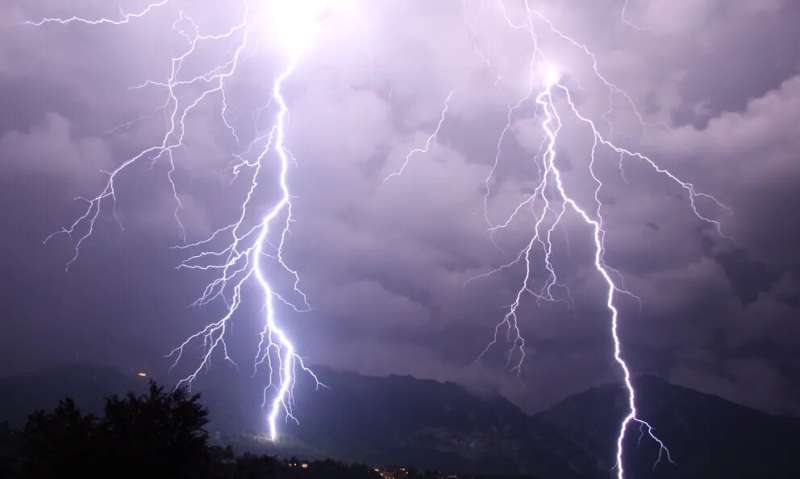This article has been reviewed according to Science X's editorial process and policies. Editors have highlighted the following attributes while ensuring the content's credibility:
fact-checked
peer-reviewed publication
trusted source
proofread
Study finds lightning activity in Alps has doubled in a few decades

In the high altitudes of the European Eastern Alps, the number of detected lightning strikes has doubled in the course of the last 40 years. Causes for this are to be found in the effects of the climate crisis. A team of Innsbruck researchers from the Departments of Geosciences, Atmospheric Sciences and Statistics has now published their findings in the journal Climate Dynamics.
The climate crisis is leading to an increase in extreme weather events today and in the future, as the Intergovernmental Panel on Climate Change (IPCC) has already pointed out several times. How the consequences of global warming affect small-scale and local weather phenomena such as lightning activity is still not fully understood.
The Innsbruck team with atmospheric and statistical scientists Thorsten Simon, Georg Mayr, Deborah Morgenstern, Nikolaus Umlauf and Achim Zeileis has now reconstructed the lightning activity of cloud-to-ground lightning in the area of the European Eastern Alps for a period between 1980 and 2019 with unprecedented precision using a special combination of extensive data sets.
"In this study, we link two sources of information, both available at a spatio-temporal resolution of 32 km x 32 km and one hour. From these datasets we obtain, on the one hand, information on lightning activity with seamless records over the last decade. On the other hand, we access analyses of atmospheric conditions—including cloud microphysics—at an hourly resolution over the past four decades," explains Thorsten Simon.
"By using machine learning, we were able to map the gapless lightning measurements from 2010 to 2019 with meteorological data. We then used machine learning and the meteorological data to reconstruct lightning frequencies further into the past, i.e., for a time when there were no such lightning measurements. And this even extends to variations in the diurnal cycle." The data come from the ALDIS lightning detection system and the atmospheric analyses from the fifth ERA-5 reanalysis of the European Center for Medium-Range Weather Forecasts ECMWF (ERA5).
Increase by 50% in the diurnal cycle
Mountainous areas have good conditions for the development of thunderstorms due to its topography alone. "Our analyses over this terrain have now shown that the rising temperatures due to climate change are causing the frequency of thunderstorms and thus lightning to increase even further. The fact that this trend is so clearly in line with global changes in the climate system also surprised us," Simon says.
According to the Innsbruck scientists, the most intensive changes occurred in the high Alps between 1980 and 2019. "There, lightning activity doubled in the 2010s compared to the 1980s. In the high-altitude areas of the Eastern Alps, the lightning season reaches a stronger maximum and starts a month earlier. During the day, the peak is up to 50% stronger, with more lightning in the afternoon and evening," says Thorsten Simon. "Similar signals along the southern and northern edges of the Alps are present, but weaker. The flat areas around the Alps show no significant trend."
By taking a comprehensive look at different processes over the complex terrain of the Alps, the researchers make an important contribution to understanding the relationships between weather, climate and lightning activity. "This is important not least for the appropriate development of preventive measures to protect people and the environment from the potential damage caused by lightning strikes," says Thorsten Simon.
More information: Thorsten Simon et al, Amplification of annual and diurnal cycles of alpine lightning, Climate Dynamics (2023). DOI: 10.1007/s00382-023-06786-8
Journal information: Climate Dynamics
Provided by University of Innsbruck



















